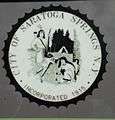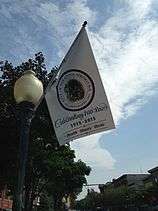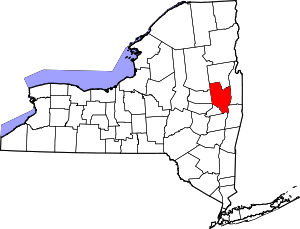Saratoga Springs, New York
| Saratoga Springs | |||
|---|---|---|---|
| City | |||
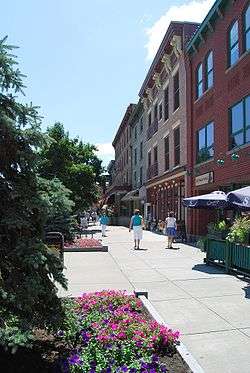 A view of downtown, looking south along Broadway from its intersection with Caroline Street. | |||
| |||
| Nickname(s): The Spa City, 'Toga | |||
| Motto(s): Health, History, Horses | |||
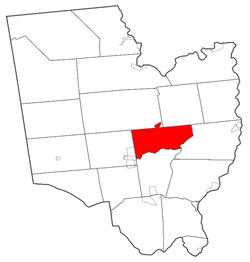 Location within Saratoga County | |||
.svg.png) Location of New York in the United States | |||
| Coordinates: 43°04′59″N 73°47′04″W / 43.08306°N 73.78444°WCoordinates: 43°04′59″N 73°47′04″W / 43.08306°N 73.78444°W | |||
| Country |
| ||
| State |
| ||
| County | Saratoga | ||
| Founded | ca. 1776 | ||
| Government | |||
| • Type | Saratoga Springs City Hall | ||
| • Mayor |
Meg Kelly (D) | ||
| Area[1] | |||
| • Total | 28.87 sq mi (74.78 km2) | ||
| • Land | 28.07 sq mi (72.69 km2) | ||
| • Water | 0.81 sq mi (2.09 km2) | ||
| Elevation[2] | 305 ft (93 m) | ||
| Lowest elevation | 0 ft (0 m) | ||
| Population (2010) | |||
| • Total | 26,586 | ||
| • Estimate (2016)[3] | 27,763 | ||
| • Density | 989.24/sq mi (381.95/km2) | ||
| Time zone | UTC−5 (EST) | ||
| • Summer (DST) | UTC−4 (EDT) | ||
| ZIP Code(s) | 12866 | ||
| Area code(s) | 518 | ||
| FIPS code | 36-091-65255 | ||
| FIPS code | 36-65255 | ||
| GNIS feature ID | 964489[4] | ||
| Wikimedia Commons | Saratoga Springs, New York | ||
| Website | http://www.saratoga-springs.org/ | ||
Saratoga Springs is a city in Saratoga County, New York, United States. The population was 26,586 at the 2010 census.[5] The name reflects the presence of mineral springs in the area, which has made Saratoga a popular resort destination for over 200 years.
Saratoga Springs was ranked tenth in the list of the top 10 places to live in New York State for 2014 according to the national online real estate brokerage Movoto.[6]
History
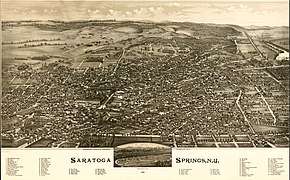
The picturesque area was occupied by the Algonquian-speaking Mahican Indians before they were forced out by Dutch and British colonists. The Mahicans eventually moved east, allied with other remnant peoples, and settled near Stockbridge, Massachusetts, where they became known as the Stockbridge Indians.
The British built Fort Saratoga in 1691 on the west bank of the Hudson River. Shortly thereafter, British colonists settled the current village of Schuylerville about a mile south; it was known as Saratoga until 1831.
Native Americans believed the springs about 10 miles (16 km) west of the village — today called High Rock Spring — had medicinal properties. In 1767, William Johnson, a British soldier who was a hero of the French and Indian War, was brought by Native American friends to the spring to treat his war wounds. (In 1756, Johnson had been appointed British Superintendent of Indian Affairs in the Northeast region due to his success in building alliances with the Mohawk and other Iroquois tribes. He had learned the language, and created many trading relationships. He achieved great wealth from trading and landholdings, and was knighted for his service to the Crown with the Iroquois.)
The first permanent European-American settler built a dwelling about 1776[7]. The springs attracted tourists, and Gideon Putnam built the first hotel for travelers. Putnam also laid out the roads and donated land for use as public spaces.
The Battle of Saratoga, the turning point of the Revolutionary War, did not take place in Saratoga Springs. Rather, the battlefield is 15 miles (24 km) to the southeast in the Town of Stillwater. A museum dedicated to the two battles sits on the former battlefields. The British encampment before the surrender at Saratoga took place 10 miles (16 km) east of the city, in Schuylerville, where several historical markers delineate points of interest. The surrender of the sword of battle took place where Fort Saratoga had been, south of Schuylerville.
Saratoga Springs was established as a settlement in 1819 from a western portion of the Town of Saratoga. Its principal community was incorporated as a village in 1826 and the entire region became a city in 1915. Tourism was greatly aided by the 1832 arrival of the Saratoga and Schenectady Railroad, which brought thousands of travelers to the famous mineral springs. Resort hotels developed to accommodate them. Patronage of the railroad increased steadily after the Delaware and Hudson Canal Company assumed control in 1870 and began running the Empire State Express directly between New York City and the resort.[8]
In the 19th century, noted doctor Simon Baruch encouraged developing European-style spas[9] in the United States as centers for health. With its wealth of mineral waters, Saratoga Springs was developed as a spa, generating the development of many large hotels, including the United States Hotel[10] and the Grand Union Hotel. The latter was, in its day, the largest hotel in the world.[8]
In 1863, Saratoga Race Course opened, moving to its current location the following year. Horse racing and its associated betting greatly increased the city's attraction as a tourist destination at a time when horse racing was a popular national spectator sport. In addition, the Saratoga Springs area was known for its gambling, which after the first years of the 20th century was illegal, but still widespread. Most gambling facilities were located on Saratoga Lake, on the southeast side of the city.
During the 1950s, the state and city closed the famed gambling houses in a crackdown on illegal gambling. The closing and demolition in the 1950s of some premier hotels, including the Grand Union and United States hurt tourism to Saratoga Springs.
The city started to prosper again in the 1960s with the completion of the Adirondack Northway (Interstate 87), which allowed visitors from the north and south much easier access. In addition, the construction of the Saratoga Performing Arts Center in the late 1960s, which features classical and popular music and dance, furthered the city's renaissance. The New York City Ballet and the Philadelphia Orchestra have summer residencies there, together with other high-quality dance groups and musicians. Since the early 1990s, there has been a boom of building, both residential and retail, in the west side and downtown areas of the city.
According to legend, the creation of the potato chip is associated with Saratoga Springs. The legend holds that a diner visiting the restaurant Moon's Lake House in Saratoga Springs in 1853 was unsatisfied with the texture of the fried potatoes he had ordered and sent them back to the kitchen multiple times in protest. The chef, George Crum, allegedly became so annoyed with the customer that he sliced the potatoes much thinner than he usually would, covered them in salt, and deep fried them. The customer was finally satisfied.[11]
Geography
According to the United States Census Bureau, the city has a total area of 29.1 square miles (75 km2), of which 28.4 square miles (74 km2) is land and 0.6 square miles (1.6 km2) (2.17%) is water.
The Adirondack Northway (Interstate 87) and US Route 9 pass alongside and through the city, respectively. New York State Route 29, New York State Route 50, New York State Route 9N, and New York State Route 9P lead into Saratoga Springs. NY 9N has its southern terminus and NY 9P has its northern terminus in the city. US 9 and NY 50 overlap in the city, joined briefly by NY 29.
Saratoga Lake is southeast of the city.
Climate
| Climate data for Saratoga Springs, New York | |||||||||||||
|---|---|---|---|---|---|---|---|---|---|---|---|---|---|
| Month | Jan | Feb | Mar | Apr | May | Jun | Jul | Aug | Sep | Oct | Nov | Dec | Year |
| Record high °F (°C) | 67 (19) |
64 (18) |
88 (31) |
92 (33) |
96 (36) |
99 (37) |
99 (37) |
96 (36) |
94 (34) |
88 (31) |
82 (28) |
67 (19) |
99 (37) |
| Average high °F (°C) | 31 (−1) |
35 (2) |
45 (7) |
60 (16) |
72 (22) |
80 (27) |
83 (28) |
82 (28) |
74 (23) |
60 (16) |
48 (9) |
36 (2) |
58.8 (14.9) |
| Average low °F (°C) | 13 (−11) |
15 (−9) |
24 (−4) |
36 (2) |
46 (8) |
55 (13) |
60 (16) |
58 (14) |
50 (10) |
39 (4) |
31 (−1) |
20 (−7) |
37.3 (2.9) |
| Record low °F (°C) | −33 (−36) |
−29 (−34) |
−13 (−25) |
5 (−15) |
21 (−6) |
32 (0) |
37 (3) |
31 (−1) |
22 (−6) |
14 (−10) |
2 (−17) |
−23 (−31) |
−33 (−36) |
| Average precipitation inches (mm) | 3.29 (83.6) |
2.62 (66.5) |
3.44 (87.4) |
3.60 (91.4) |
4.08 (103.6) |
4.32 (109.7) |
4.53 (115.1) |
4.21 (106.9) |
3.60 (91.4) |
4.01 (101.9) |
3.79 (96.3) |
3.37 (85.6) |
44.86 (1,139.4) |
| Source: Weather.com (Monthly Averages for Saratoga Springs, NY (12866))[12] | |||||||||||||
Demographics
| Historical population | |||
|---|---|---|---|
| Census | Pop. | %± | |
| 1870 | 7,516 | — | |
| 1880 | 8,423 | 12.1% | |
| 1890 | 11,975 | 42.2% | |
| 1900 | 12,409 | 3.6% | |
| 1910 | 12,693 | 2.3% | |
| 1920 | 13,181 | 3.8% | |
| 1930 | 13,169 | −0.1% | |
| 1940 | 13,705 | 4.1% | |
| 1950 | 15,473 | 12.9% | |
| 1960 | 16,630 | 7.5% | |
| 1970 | 18,845 | 13.3% | |
| 1980 | 23,906 | 26.9% | |
| 1990 | 25,001 | 4.6% | |
| 2000 | 26,186 | 4.7% | |
| 2010 | 26,586 | 1.5% | |
| Est. 2016 | 27,763 | [3] | 4.4% |
| U.S. Decennial Census[13] | |||
2012
According to the 2010 U.S. Census Bureau:
- 92.5% White
- 1.7% Black
- 0.1% Native American
- 2.01% Asian
- 0.0% Native Hawaiian or Pacific Islander
- 3.1% Two or more races
- 0.64% Other races
- 4.0% Hispanic or Latino (of any race)
As of the census[5] of 2012, there were 26,711 people, 11,312 households, and 5,923 families residing in the city. The population density was 921.1 people per square mile (355.6/km2). There were 11,584 housing units at an average density of 407.5 per square mile (157.3/km2). The racial makeup of the city was 92.5% White, 1.7% African American, 0.1% Native American, 2.01% Asian, 0.00% Pacific Islander, 0.64% from other races, and 3.1% from two or more races. Hispanic or Latino of any race were 4.0% of the population.
There were 11,312 households out of which 25.3% had children under the age of 18 living with them, 43.1% were married couples living together, 9.6% had a female householder with no husband present, and 44.5% were non-families. 35.0% of all households were made up of individuals and 12.3% had someone living alone who was 65 years of age or older. The average household size was 2.21 and the average family size was 2.88.
In the city, the age distribution of the population shows 19.4% under the age of 18, 15.5% from 18 to 24, 27.5% from 25 to 44, 23.4% from 45 to 64, and 14.3% who were 65 years of age or older. The median age was 36 years. For every 100 females, there were 90.4 males. For every 100 females age 18 and over, there were 87.1 males.
In 2012, the median income for a household was $91,392, while the mean income for a family was $114,560.[14] The median income for a household in the city was $62,766, while the mean income for a household was $81,807.[15] Males had a median income of $61,582 versus $47,759 for females. About 3.0% of families and 7.5% of the population were below the poverty line, including 7.3% of those under age 18 and 6.3% of those age 65 or over.[14]
Business
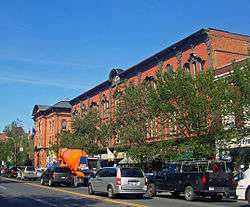
Saratoga Springs relies heavily on tourism as its main source of income during the summer season while the Saratoga Race Course is open. Many residents commute daily to Albany via Interstate 87, Interstate 787, and Interstate 90. The business district in Saratoga increasingly contributes to the economy year round, as the city has attracted many national and international brand retailers, as well as local boutiques; it has become an upscale shopping destination for the Albany metropolitan area.
In industry, the Saratoga Spring Water Co. (a division of Anheuser-Busch InBev) is located on Geyser Road. Operating since 1872, the water has been served during many presidential inaugurations in Washington, D.C., including Barack Obama's in 2013.[16] Quad/Graphics, offset printers of Time, Newsweek, People, Sports Illustrated and many other magazines, has a plant here, and Ball Corporation, makers of the Mason Jar as well as aluminum cans, for companies such as Pepsi and Anheuser-Busch InBev, has a large manufacturing plant in the city. Stewart's Shops, a popular convenience store chain, which is an employee- and family-owned business, is headquartered in Saratoga Springs. Stewart's has more than 300 stores throughout New York and Vermont.
Sports
Thoroughbred racing
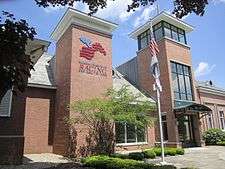
The city is perhaps best known for the Saratoga Race Course, which opened on August 3, 1863. The first track was located on East Avenue (at the present Oklahoma Training Track location) which is perpendicular to the present Saratoga Race Course, which opened the following year. Founded by John Hunter and William R. Travers, the thoroughbred track is the oldest continuously-operating sporting event of any kind in the United States. The track holds a summer meet lasting six weeks, from late July to Labor Day, that attracts the top horses, jockeys, and trainers in America. The meet features a number of major stakes races, with the Travers Stakes, a Grade I race, being one of the most prominent of America's summer horse races.
Harness racing
Saratoga Casino and Raceway, a harness (Standardbred) racetrack that includes a hotel, video gaming facility, a nightclub, an upscale steakhouse, the Racino, and a horse betting simulcast room.
Golf
- Saratoga Golf and Polo Club (private)
- Saratoga National Golf (public)
- Saratoga Spa Golf -Located in Saratoga Spa State Park (public)
- Airway Meadows Golf Club (public)
- McGregor Links Country Club (semi-private)
Polo
- The Saratoga Polo Association plays Fridays and Sundays mid-July through early September at Whitney Field in nearby Greenfield Center
Youth Sports
- Saratoga Youth Wrestling
- Saratoga Youth Lacrosse
- Saratoga-Wilton Youth Baseball
- Saratoga Little League
- Saratoga Youth Hockey
- Saratoga Figure Skating
- Saratoga Sharks (Swimming)
- Saratoga Wilton Soccer Club
- Saratoga Pop Warner (Football, Cheer)
- Saratoga Basketball
- Saratoga Martial Arts
- Saratoga Springs Field Hockey
- Olde Saratoga Farms (Horseback Riding)
Saratoga YMCA offers many these and other sports and there are private programs offered in Saratoga. These are the public programs.
Culture
- Theater – Home Made Theater- A not-for-profit theatre company located in the Spa Little Theater of Saratoga Spa State Park
- Ballet – New York City Ballet at Saratoga Performing Arts Center, Saratoga City Ballet
- Opera – Opera Saratoga
- Music - Caffe Lena, Saratoga Performing Arts Center, Saratoga Music Hall
Springs

Before racing began in Saratoga, the area's natural mineral springs had been attracting wealth for many decades. The springs occur on a line where the north-south Saratoga Fault allows water trapped in subsurface shale layers to reach the surface.
Believed to have healing powers, springs can be found all over town. Most of the springs are covered by small pavilions and marked by plaques; others, however, are less conspicuous, sometimes just a spigot in a rock. The springs are famous for their varied and distinct tastes: some are clear freshwater, others are saltier, and some taste strongly of a certain mineral such as sodium bicarbonate or sodium chloride. There is a sulfur odor, but mineral analysis of the water consistently shows almost no presence of dissolved sulfur. The sulfur is in the form of the gas hydrogen sulfide, which degasses from the water very quickly. Visitors are welcome to bottle the spring water for personal consumption.
Toward the end of the nineteenth century excessive pumping for commercial bottling was threatening to deplete the springs. In 1911 the New York State Reservation, now the Spa State Park, was created to protect the springs and the Lincoln and Roosevelt bath houses were built. Currently, luxury spa treatments with these waters are available in the Roosevelt Baths. [17] The springs include:
|
|
Other springs popular in the nineteenth century which are no longer in use include the Hamilton Spring, the Patterson Spring, and the Favorite Spring.[18]
Arts and entertainment
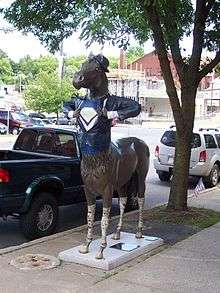
The Saratoga Performing Arts Center (known by its acronym "SPAC") is a covered outdoor amphitheater located on the grounds of the Saratoga Spa State Park, with a capacity of 5,000 in reserved seating and 20,000+ on its general admission lawn area. SPAC is the summer home of the Philadelphia Orchestra and the New York City Ballet, and has hosted a weekend-long jazz festival since 1978.[19] Since 2006, the Saratoga Native American Festival has been held on SPAC grounds each fall.[20] SPAC is a stop for touring national recording artists: over 20 popular bands grace the stage every summer. Steps away on State Park grounds, the Spa Little Theater hosts the "Home Made Theater" as well as Opera Saratoga (formerly known as the Lake George Opera) during the summer.
Museums in the area include the National Museum of Dance and Hall of Fame, the National Museum of Racing and Hall of Fame, and the Saratoga Automobile Museum. There are more than 20 golf courses in the area. The city is notable for its vibrant night life. Caffè Lena was one of the first venues in the Eastern US at which Bob Dylan performed in 1961. Arlo Guthrie played at Caffè Lena early in his career and has returned for occasional benefit concerts, and the singer Don McLean was a frequent performer there early in his career. (Contrary to a popular legend, McLean has stated that his song "American Pie" was not composed at a table in the Tin & Lint, a bar on Caroline Street.[21]) Numerous other establishments are located on Broadway, Caroline Street (the Hamilton district), and the redeveloped Putnam Street.
Recently, Beekman Street (four blocks West of Broadway), once the center of a working-class residential neighborhood, has become an art district, housing four galleries, a restaurant, a pub and teahouse, and a bistro. Artists live and work in co-ops and arrange social events. While some take credit for "revitalizing" a "deteriorating" area, others consider such declarations an insult to the generations of minority and marginalized ethnicities who worked in the service jobs of the tourism economy, and were traditionally segregated to this once-remote quarter.
Saratoga Springs is home to Yaddo, a 400-acre (1.62 km2; 0.63 sq mi) artists' community, founded by Wall Street financier Spencer Trask and his wife, author Katrina Trask. Since its inception in 1900, Yaddo has hosted 68 authors who later won the Pulitzer Prize and one Nobel Prize winner, Saul Bellow. Leonard Bernstein, Truman Capote, Aaron Copland, Sylvia Plath, and David Sedaris have all been artists-in-residence.[22] The Yaddo grounds are adjacent to the backstretch of the Saratoga Race Course.
Saratoga's New Year's celebration First Night Saratoga is the largest New Year's Eve event in New York outside of New York City.[23]
Museums
- The Frances Young Tang Teaching Museum and Art Gallery at Skidmore College
- Schick Art Gallery, Skidmore College
- National Museum Of Dance And Hall Of Fame
- National Museum of Racing and Hall of Fame
- New York State Military Museum And Veterans Research Center
- Saratoga Automobile Museum
- Saratoga Springs History Museum
- Children's Museum of Saratoga
- Saratoga Arts Center
Media
- Grid (formerly Saratoga Wire) daily online newspaper
- The Saratogian newspaper (daily)
- Saratoga TODAY newspaper (weekly) www.saratogatodaynewspaper.com
- Saratoga Business Journal newspaper (bi-weekly)
- The Spotlight newspaper (weekly)
- Eco Local magazine (monthly)
- Saratoga Seasons magazine
- Saratoga Living magazine (quarterly)
- Simply Saratoga magazine (by-monthly) www.saratogatodaynewspaper.com
- The Skidmore News
- Skidmore Unofficial
- Saratoga.com
- Saratogabusiness.net
- Look TV television station
Government
The Saratoga Springs charter specifies a "commission" form of city government. Recent efforts to amend the charter have not been successful. The most recent charter change proposal appeared on the ballot in the November 2017 election and was narrowly defeated by 10 votes.[24]
The current elected officials for the City of Saratoga Springs are:
- Mayor Meg Kelly
- Commissioner of Finance Michele Madigan
- Commissioner of Public Works Anthony "Skip" Scirocco
- Commissioner of Public Safety Peter Martin
- Commissioner of Accounts John P. Franck
The county supervisors for the city are Matthew Veitch and Tara N. Gaston.
The city is one of only three in the state of New York to have a three-tier tax district system, the inside district being what was originally the village of Saratoga Springs, and the outside district being the town of Saratoga Springs minus the village. The other two cities with three-tier tax system are Rome and Oneida.
Transportation

The closest scheduled air service is available at Albany International Airport (ALB). There is also a general aviation facility, Saratoga County Airport (5B2), located west of city limits in the Town of Milton.
Amtrak, the national passenger rail system, provides service to Saratoga Springs, operating its Adirondack daily in both directions between Central Station in Montreal and Penn Station in New York City and the Ethan Allen Express daily in both directions between Rutland, Vermont and New York City. The local station off of West Avenue was built in 1956, but dramatically rehabilitated in 2004. The 6,400-square-foot (590 m2) passenger area contains a coffee shop/newsstand, murals, an automated teller machine, a visitors information kiosk, an outside patio area with benches, and a children's play area. The station serves about 23,000 passengers every year.
Greyhound Bus Lines also serves the city frequently, sending buses every few hours towards Albany or Montreal. The city Amtrak station serves as the Greyhound Bus Lines and Adirondack Trailways Bus Lines station. The city is also served by the Capital District Transportation Authority, which provides bus service from Schenectady via Route 50 daily, and weekday service to Albany via the Northway Express line. Low-cost curbside bus service is also provided by Megabus, with direct service to New York City and Burlington, Vermont.
Long-distance motorists generally reach Saratoga via Interstate 87, which north of Albany is known as the Adirondack Northway. Three exits access the city. Exit 13-S is optimal for reaching Saratoga Lake, and 13-N for the Saratoga Performing Arts Center (SPAC) and the southern and western quadrants of the city. Visitors to the Saratoga Race Course use Exit 14, which is also arguably best for reaching downtown from the south. Exit 15 serves Skidmore College, downtown if coming from the north, and the shopping malls just north of city limits.
Education and recreation
Empire State College and Skidmore College are both located in Saratoga Springs; Verrazzano College (1969–1975)[25][26] was also located there. During the summer, Skidmore is one of several hosts for the Johns Hopkins Center for Talented Youth. Eastern Nazarene College, located in Quincy, Massachusetts, was founded in Saratoga Springs as the Pentecostal Collegiate Institute and Biblical Seminary at the turn of the 20th century.
The Saratoga Springs City School District[27] is made up of:
- Six elementary schools (kindergarten through grade five) — Lake Avenue, Caroline Street, Division Street and Geyser Road in the City of Saratoga Springs; Greenfield in the Town of Greenfield; and Dorothy Nolan in the Town of Wilton
- One middle school (grades six through eight) — Maple Avenue Middle School in the Town of Wilton
- One high school (grades nine through twelve) — Saratoga Springs High School located on the West side on Blue Streak Boulevard in the City of Saratoga Springs.
Private schools in Saratoga Springs include Saratoga Central Catholic High School, St. Clement's Regional Catholic School, The Waldorf School of Saratoga Springs, and Saratoga Independent School. Alternatively, some local children commute to Albany area schools such as The Emma Willard School, The Albany Academies, Doane Stuart School and La Salle Institute.
Saratoga Spa State Park
The Saratoga Spa State Park capitalizes on the culture and mineral springs that drove Saratoga Springs. This is a large state park and includes a hotel, 2 pool complexes, mineral baths, Saratoga Performing Arts Center (SPAC), picnic areas, hiking trails and numerous mineral springs. The Saratoga Performing Arts Center, located on the State Park grounds, has been the summer home of the Philadelphia Orchestra and New York City Ballet since 1966. Jazz and dance are featured at SPAC. The SPAC Amphitheater itself is 110 feet (34 m) high, sits in a natural, curved bowl that is bordered by large pine trees and a large lawn space, but is afflicted by the roar of nearby Geyser Creek, which creates serious acoustical problems. Inside the amphitheater is seating for 5100, the lawn can easily hold an additional 20,000 people. The park is also home to the National Museum of Dance and Hall of Fame, the Saratoga Automobile Museum, the Lincoln Mineral Baths and Spa, and the Gideon Putnam Resort & Spa.
Skateboard Park

The Saratoga Skatepark (est. 1988), located in the center of the East Side Recreation area on Lake Avenue, is New York State's first municipal skatepark. The exercise facility is known for its concrete skateboard pool, installed with a state-of-the-art design in 2004 and has metal ramps as well. In 2010 the city filled the pool with dirt, citing problems with graffiti, vandalism and unconfirmed structural issues affecting the skating surface. In addition, the city said that they lacked funds to staff guards at the park and claimed it had spent nearly $200,000 on the park since it opened in 1988.[28] After a group of skateboarders lobbied the city and publicly offered to dig out the pool by hand, the city excavated it in November 2011.[29][30] The skatepark is now free, open to the public and endorses a skate-at-your-own-risk policy per the New York Recreational Use Statute.
Notable people
Actors
- Charles Brackett, Hollywood screenwriter and producer
- Dave Cummings, Adult Hall of Fame performer, grew up in Saratoga Springs
- David Hyde Pierce,[31] American actor, best known for his role in the sitcom "Frasier" as Dr. Niles Crane. 1977 Saratoga Springs High School graduate and winner of the Yaddo Medal
- Scott Valentine, television (Family Ties) and motion picture actor, graduate of Saratoga Springs High School
- Monty Woolley, American actor, best known for his role in the play The Man Who Came to Dinner; grew up in Saratoga Springs, where his father managed the Grand Union Hotel
Sports figures
- Jerry Bailey, Retired jockey, Jerry Bailey has no relation to Saratoga other than racing at the Saratoga Race Course and spending his summers in Saratoga
- Dave Erb, 1956 Kentucky Derby and Belmont Stakes winner on the colt Needles, won many other stakes races; lives in neighboring Greenfield, New York, which borders Saratoga Springs
- Kathleen Kauth, hockey player; 2006 Olympic bronze medalist; currently plays for the NWHL's Brampton Thunder
- Justin Morrow, figure-skater; two-time national ice-dancing medalist; 2005 Saratoga Springs High School graduate
- Bill Parcells, retired football coach; owns a summer/retirement home overlooking a local golf course[32]
- Don Pepper, baseball player who played one season with the Detroit Tigers (1966); father of LPGA golfer Dottie Pepper-Normoyle
- Dottie Pepper-Normoyle, golfer; 1983 graduate of Saratoga Springs High School, daughter of Major League basketball player Don Pepper
- Giana Roberge, professional cyclist; 2004 Master's World Time-Trial Champion; former owner of Paradox Bicycle Center on Church St.; Skidmore graduate
- Tim Stauffer, Major League Baseball pitcher; attended Saratoga Central Catholic High School
- Anthony Weaver, football player; former defensive end with the Baltimore Ravens and Houston Texans, 1998 Saratoga Springs High School graduate
- Amy Peterson, 5 time olympian, speed skater, 5 time medalist, currently lives in Saratoga Springs
- Matthew Riddle, UFC fighter
Musicians
- Frederick Charles Adler, Anglo-German composer promoted music here during and after World War II
- Callen Sisters (Jess and Beth), sister musicians; 2001 and 2002 Saratoga Springs High School graduates, respectively
- Dorian Crozier, drummer who has sat in with Five for Fighting and The Rembrandts; 1989 Saratoga Springs High School graduate
- Dave Luetkenhoelter, bass player for Kutless; lived in Saratoga Springs for a short time during high school
- Chauncey Olcott, famed Irish tenor and composer, author of My Wild Irish Rose maintained a home Inniscara in Saratoga Springs
- Sarah Pedinotti, young jazz singer with albums positively review by Billboard Magazine; parents opened One Caroline Street Bistro in 1996
- Utah Phillips, while not a native, began his career as a professional musician while living in Saratoga
- Scott Underwood, drummer for and member of Train; 1991 Saratoga Springs High School graduate[33]
- Trey Anastasio, an American guitarist, composer, and vocalist noted for his work with the rock band Phish
Authors/journalists
- Jeff Goodell, author and contributing editor to Rolling Stone magazine
- James Howard Kunstler, writer and social critic, former resident, since moved to Washington County, New York
- Frank Leslie (1821–1880), publisher of Frank Leslie's Illustrated Newspaper owned a summer home Interlaken on Lake Lonely.
- Ingersoll Lockwood (1841–1918), lawyer and writer, author of the Baron Trump novels, retired to Saratoga Springs and died there in 1918[34]
- John McPherson, internationally syndicated cartoonist, creator of the comic "Close to Home"
- Steven Millhauser, writer, winner of 1997 Pulitzer Prize, lives in Saratoga Springs
- Frank Sullivan, writer, The New Yorker
- Katrina Trask (1853–1922), poet and playwright. Wife of Spencer Trask
- Dale Willman, award-winning journalist, co-publisher of Saratoga Wire, a local on-line news source
- Craig Wilson, columnist for USA Today, formerly columnist for the Saratogian
Others
- Mohammed bin Rashid Al Maktoum, Prime Minister of the United Arab Emirates, thoroughbred-racing enthusiast; owns a horse farm in Saratoga[35]
- George S. Bolster (1913–1989), photographer
- Edgar T. Brackett (1853–1924), lawyer, New York State Senator, founder of the Adirondack Trust Company
- Nelson Cook (1808–1892), painter, lived in Saratoga Springs
- Ransom Cook (1794–1881), long-time resident of Saratoga, inventor of the Cook Auger, or "Beetle Bit"[36]
- George Crum, inventor of the potato chip; a Native American/African American chef at Moon's Lake House on Saratoga Lake[36]
- Charles F. Dowd (1825–1904), co-principal with his wife Harriet M. Dowd of the Temple Grove Ladies Seminary, now Skidmore College
- Albert Warren Ferris (1856–1937), Director of Saratoga Springs State Reservation Commission from 1913–1916
- Ulysses S. Grant, late life resident; died of cancer in 1885 at his cottage on Mt. McGregor just north of Saratoga Springs
- Hattie Moseley Austin, restaurateur, founder of Saratoga institution, Hattie's Chicken Shack[37]
- Gene Markey (1895–1980), screenwriter, producer, U.S. Naval officer owned a home in Saratoga Springs
- Solomon Northup, musician who was kidnapped into slavery in 1841 and held in Louisiana for 12 years before being freed; his 1853 memoir Twelve Years a Slave was a bestseller
- Matt Rhoades, campaign manager for the 2012 Romney-Ryan presidential campaign
- Jane Roberts (1929–1984), author, psychic and trance medium or spirit medium, born and grew up in Saratoga Springs
- Lucy Skidmore Scribner (1853–1931), founder of The Young Women's Industrial Club, now Skidmore College
- Nick Steele, noted fashion stylist; grew up in Saratoga and his family still resides there
- Spencer Trask (1844–1909), financier and venture capitalist, builder of Yaddo
- Angeline Tubbs (1761–1865), "The Witch of Saratoga"
- Henry Walton (1804–1865), painter, born and grew up in Saratoga Springs, and produced his earliest work here.
- Ellen Hardin Walworth (1832–1915), author and suffragette, founder of the Daughters of the American Revolution
- Reuben Hyde Walworth (1788–1867), lawyer and politician. He was the last Chancellor of New York
- Marylou Whitney, socialite; maintains a home at Cady Hill
- Mollie Wilmot, socialite, philanthropist
In popular culture
Saratoga Springs, Saratoga Race Course, and Saratoga society are frequently featured on-screen and mentioned in films and television.
Films shot in and around Saratoga Springs
- 12 Years a Slave (2013) – Chiwetel Ejiofor, Lupita Nyong'o, Michael Fassbender, Benedict Cumberbatch
- A Dog Year (2009) – Jeff Bridges, Lauren Ambrose
- Aftermath (2008) – Chris Penn's last film[38]
- Ass Backwards (2013) – Casey Wilson, June Diane Raphael, Alicia Silverstone, Jon Cryer[39]
- Billy Bathgate (1991) – Dustin Hoffman, Nicole Kidman; the Kidman dancing scene was shot at the Hall of Springs[40]
- Feast of Friends (1970) – The Doors' self-produced documentary; features lengthy concert footage at SPAC (on 9/1/68) and Jim Morrison reciting poetry backstage[40]
- Ghost Story (1981) – Fred Astaire, John Houseman; houses on North Broadway were used as homes in this film. Cast included Fred Astaire, John Houseman, and Douglas Fairbanks, Jr.[40]
- The Homestretch (1947) – Maureen O'Hara, Cornel Wilde[40]
- Lolita (1962) – James Mason, Shelley Winters
- My Old Man (1979) – Kristy McNichol, Warren Oates, Eileen Brennan; made-for-TV movie, based on an Ernest Hemingway story, was filmed at Saratoga Race Course, various locations in Saratoga Springs, and throughout Saratoga County.[40]
- Nobody's Fool (1994) – Paul Newman, Bruce Willis
- Paul's Case (1980) – Eric Roberts, Lindsay Crouse[40]
- Saratoga (1937) – Clark Gable, Lionel Barrymore, Jean Harlow; notable for being Harlow's last film, as she collapsed on set during filming and died. Racing scenes were filmed at the Saratoga Race Course.[40][41]
- Saratoga Trunk (1945) – Gary Cooper, Ingrid Bergman; while it was set in Saratoga, it was not filmed there.[40]
- Seabiscuit (2003) – Tobey Maguire, Jeff Bridges; racing scenes shot at the Saratoga Race Course in November 2002.
- The Horse Whisperer (1998) – Robert Redford, Scarlett Johansson; special effects for the horse and rider accident were shot at the southern end of Saratoga Spa State Park. Also, a room at the Gideon Putnam Hotel was made into a shoddier motel room.[40]
- The Skeptic (2009) – Tom Arnold, Zoe Saldana
- The Time Machine (2002) – Guy Pearce, Samantha Mumba
- The Way We Were (1973) – Robert Redford, Barbra Streisand; scenes also shot in nearby Ballston Spa
- Virgin Alexander (2011) – Rich Faugno, Paige Howard, Bronson Pinchot[42]
Radio
- Saratoga Springs was the setting for a radio soap opera by the same name, created by ZBS Foundation and written by Meatball Fulton. The 1989 series was produced as 90 four-minute daily episodes for National Public Radio. The story incorporates Saratoga Springs historical facts and utilizes local actors as well as ZBS regulars. Lena Spencer of Caffe Lena is listed as playing herself. A "Best of Saratoga Springs" compilation (c. 2004) can be purchased from ZBS (www.zbs.org). During spring and early summer, 2007, the original four-minute episodes were podcast by ZBS.
Television
- In the pilot episode of the 1960s sitcom Green Acres, it was noted that Eddie Albert's character of Oliver Wendell Douglas was born in Saratoga Springs.
Music
- In the song "Adelaide's Lament" in the 1950 Broadway musical Guys and Dolls, Adelaide, who has an eternal cold caused by her fiancé's refusal to finally marry, sings "When they get on that train to Niagara / She can hear church bells chime / The compartment is air-conditioned / And the mood sublime... / Then they get off at Saratoga for the fourteenth time / A person can develop la grippe!"
- The 1971 song "American Pie" by Don McLean was not written at the Tin and Lint bar on Caroline Street, according to McLean (see the citation above).
- In the 1972 Carly Simon song "You're So Vain" the singer references horseracing in Saratoga Springs: "Well, I hear you went up to Saratoga, and your horse naturally won...."
- In 1987, Whitney Houston's music video for "Didn't We Almost Have It All", the second single from her second studio album, was filmed at SPAC. The video was rotated regularly on MTV and it eventually became her fifth (of a record-breaking seven) consecutive number one hits on the Billboard 100 chart.[43][44]
Food
- It is believed that potato chips were invented in Saratoga Springs, by Native American/African American chef George Crum, at Moon's Lake House on August 24, 1853.
- It is believed that the club sandwich was invented in the Canfield Casino in 1894.[45]
Other
- Walt Disney World Resort has a themed resort called Disney's Saratoga Springs Resort & Spa, whose theme and design was inspired by this city. Additionally, the Walt Disney World Railroad station at Main Street U.S.A. in the Magic Kingdom was modeled after and closely resembles the former Victorian era railroad depot that once stood in downtown Saratoga Springs.
- The James Bond novel, Diamonds are Forever contained several scenes set in Saratoga Springs and its racecourse
- Saratoga native Solomon Northup's memoir Twelve Years a Slave was made into a hit movie in 2013.
Sister cities


Gallery
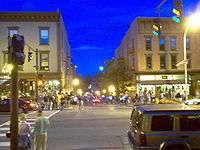 Caroline Street as seen from across Broadway
Caroline Street as seen from across Broadway A nighttime street scene on Broadway
A nighttime street scene on Broadway Broadway by day
Broadway by day
See also
- Gideon Putnam
- Caffè Lena
- Horses Saratoga Style
- Saratoga Performing Arts Center
- List of Mayors of Saratoga Springs, New York
- Geyser Crest
- Disney's Saratoga Springs Resort & Spa, a Disney resort inspired and designed like this city
- Marcia White, Executive Director of SPAC
References
- ↑ "2016 U.S. Gazetteer Files". United States Census Bureau. Retrieved Jul 5, 2017.
- ↑ "USGS detail on Newtown". Retrieved 2007-10-21.
- 1 2 "Population and Housing Unit Estimates". Retrieved June 9, 2017.
- ↑ U.S. Geological Survey Geographic Names Information System: Saratoga Springs
- 1 2 "American FactFinder". Web.archive.org. United States Census Bureau. Archived from the original on 2013-09-11. Retrieved 2008-01-31.
- ↑ "The 10 Best Places In New York – statistical analysis by Movoto". Movoto Blog. Retrieved 3 December 2017.
- ↑ "Saratoga Springs NY". WaterworksHistory. Waterworkshistory. Retrieved 6 August 2018.
- 1 2 R. F. Dearborn. "Saratoga and How to See It". gutenberg.org.
- ↑ "http://www.thesaratogalife.com/life-in-saratoga-springs-new-york/". Saratoga Life. Saratoga Life. Retrieved 6 August 2018. External link in
|title=(help) - ↑ Charles Newhall Taintor (1876). "United States Hotel". Saratoga Illustrated.
- ↑ 1956-, Smith, Merril D., (2013-01-01). History of American cooking. ABC-CLIO. ISBN 0313387117. OCLC 827334814.
- ↑ "Monthly Monthly Averages". Weather.com. Retrieved 2014-05-12.
- ↑ "Census of Population and Housing". Census.gov. Archived from the original on May 12, 2015. Retrieved June 4, 2015.
- 1 2 Data Access and Dissemination Systems (DADS). "American FactFinder – Results".
- ↑ Data Access and Dissemination Systems (DADS). "American FactFinder – Results".
- ↑ "Saratoga Spring Water chosen as official water for Presidential Inauguration – Albany Business Review". Albany Business Review. 3 August 2012.
- ↑ Saratoga Springs Heritage Area Visitor Center. "History of Saratoga". Retrieved May 25, 2013.
- ↑ Kuenzel, Charlie; Patterson, Dave. "The Lost Kineral Springs of Saratoga Springs, part 2". Simply Saratoga (January/February 2015). Saratoga Today.
|access-date=requires|url=(help) - ↑ McGuire, Mark (27 June 2012). "The first Saratoga Jazz Fest". The Times Union. Retrieved 23 April 2013.
- ↑ Willman, Dale (30 September 2012). "Native American Festival Continues at SPAC: Photo Essay". Saratoga Wire. Archived from the original on 30 June 2013. Retrieved 23 April 2013.
- ↑ Dimopoulos, Thomas (26 November 2011). "Bye, bye local legend: Don McLean refutes tale of song's origin". The Post Star. Retrieved 23 April 2013.
- ↑ "History". Yaddo. Retrieved 23 April 2013.
- ↑ Saratoga Arts Council. "First Night Saratoga". Retrieved June 30, 2014.
- ↑ http://www.saratogian.com/general-news/20171114/proposed-spa-city-charter-appears-headed-toward-defeat
- ↑ "Verrazzano makes $3 million offer for Skidmore's Scribner Campus". Skidmore News. Sep 11, 1969. Retrieved May 25, 2013.
- ↑ "New York Colleges that have Closed, Merged, Changed Names". Westminster College. Retrieved May 25, 2013.
- ↑ "Saratoga Springs City School District". Saratogaschools.org. Retrieved 3 December 2017.
- ↑ Donges, Patrick (24 March 2010). "Skateboarding bowl filled at Saratoga Springs' East Side Rec". The Saratogian. Retrieved 23 April 2013.
- ↑ Jenks, Eric (5 November 2011). "Photos: Saratoga Springs' East Side Rec skate bowl reopens". The Saratogian. Retrieved 23 April 2013.
- ↑ Yusko, Dennis (20 October 2011). "Skateboarder's moves may hit pay dirt". The Times Union. Retrieved 23 April 2013.
- ↑ "David Hyde Pierce". IMDb. Retrieved 2009-05-04.
- ↑ Humphries, Shawn (2005-10-14). "How Bill Parcells Made Big Gains". Golf Online. Archived from the original on September 27, 2007. Retrieved 2007-02-14.
- ↑ "Grammy-winning Train drummer went to school, learned to play in Saratoga Springs". Retrieved 2017-04-25.
- ↑ New York Times (3 October 1918). "Ingersoll Lockwood, Lawyer", p. 13
- ↑ Shulman, Lenny. "Sheikh Mohammed Buys Saratoga Farm". Bloodhorse.com. Retrieved May 25, 2013.
- 1 2 Invented in Saratoga County, Starr, Timothy, 2008
- ↑ Collins, Glenn (August 10, 2010). "In Saratoga Springs, Catering to the Horse Set". New York Times. Retrieved May 25, 2013.
- ↑ Aftermath on IMDb
- ↑ "Ass Backwards (2013)". Internet Movie. Retrieved 19 August 2012.
- 1 2 3 4 5 6 7 8 9 Bucciferro, Maria McBride. "Saratoga on the Silver Screen II: The Glory Days of Film Return to the Spa". Saratoga Living. Saratoga Living LLC. 17 (2).
|access-date=requires|url=(help) - ↑ "Saratoga (1937)". Internet Movie Database. Retrieved 2007-04-01.
- ↑ Post, Paul (25 July 2012). "Film shot in Saratoga Springs released on DVD; "Virgin Alexander" has won multiple awards". The Saratogian. Retrieved 19 August 2012.
- ↑ TatanBrown (17 October 2008). "Whitney Houston - Didn't We Almost Have It All [Album Version]". YouTube. Retrieved 3 December 2017.
- ↑ "Whitney Houston Performs At SPAC (1987)". Sratoga.com. 13 February 2012. Retrieved 3 December 2017.
- ↑ Stradley, Linda (2004). "History of Club Sandwich". What's Cooking America?. Retrieved 2009-07-31.
- ↑ "National Commission for Decentralised cooperation". Délégation pour l'Action Extérieure des Collectivités Territoriales (Ministère des Affaires étrangères) (in French). Archived from the original on 2013-10-04. Retrieved 2013-12-26.
- ↑ Diakopoulos, Christopher (2006-04-27). "City looks to get new sister". The Saratogian. Journal Register Company. Retrieved 2006-09-07.
Further reading
- "Saratoga Springs". A Gazetteer of the State of New York. J. Disturnell. 1842.
- "Illustrated Views of Saratoga and its Springs", Gleason's Pictorial Drawing-Room Companion, 1852
- The Traveler's Guide to the Hudson River, Saratoga Springs, Lake George, Falls of Niagara and Thousand Islands. American News Company. 1864.
- Child, Hamilton (1871), "Saratoga Springs", Gazetteer and business directory of Saratoga County, N.Y., and Queensbury, Warren County, for 1871, Syracuse: Printed at the Journal Office
- Joseph Sabin, ed. (1889). "Saratoga, N.Y.". Bibliotheca Americana. 18. New York. OCLC 13972268.
- Federal Writers' Project (1940). "Saratoga Springs". New York: A Guide to the Empire State. American Guide Series.
- Dimopoulos, Thomas (2015). Saratoga Stories: Magic and Loss. Manchester, Vt.: Shires Press. ISBN 978-1-60571-260-4. OCLC 2015940720.
External links
| Wikimedia Commons has media related to Saratoga Springs, New York. |
| Wikivoyage has a travel guide for Saratoga Springs. |
| Wikisource has the text of the 1920 Encyclopedia Americana article Saratoga Springs. |
- Official website
- Saratoga Convention and Tourism Bureau
- The Ultimate Guide to Saratoga County and Saratoga Springs, NY — Official site
- Saratoga County History
- Online Guide to Saratoga Springs, NY
- Saratoga Springs Centennial website
- Our Town: Saratoga Springs Documentary produced by WMHT (TV)
- "Local History Resources". Saratoga Springs Public Library.
- Digital Public Library of America. Items related to Saratoga Springs, various dates

